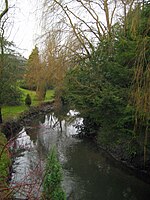Pattingham
Former civil parishes in StaffordshireSouth Staffordshire DistrictUse British English from October 2016Villages in Staffordshire

Pattingham is a village and former civil parish, now in the parish of Pattingham and Patshull, in the South Staffordshire district, in the county of Staffordshire, England, near the county boundary with Shropshire. Pattingham is seven miles west of Wolverhampton and seven and a half miles east of Bridgnorth. In 2021 it had a population of 1773.
Excerpt from the Wikipedia article Pattingham (License: CC BY-SA 3.0, Authors, Images).Pattingham
Clive Road, South Staffordshire Pattingham and Patshull
Geographical coordinates (GPS) Address Nearby Places Show on map
Geographical coordinates (GPS)
| Latitude | Longitude |
|---|---|
| N 52.58964 ° | E -2.26291 ° |
Address
Clive Road
Clive Road
WV6 7BU South Staffordshire, Pattingham and Patshull
England, United Kingdom
Open on Google Maps







